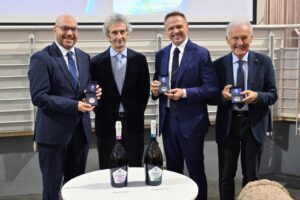
The Holy Father in the land of Sagrantino, the wine of Saint Francis: Pope Leo XIV arrived this morning in Montefalco, in the heart of Umbria, for a visit to the Augustinian nuns of the Monastery of Santa Chiara. Here, the Pope celebrated Mass and then had lunch with the sisters, enjoying a typically Umbrian menu before returning to the Vatican. And, it is precisely in this 13th-century convent that the ancient Sagrantino plants were preserved, vine-symbol of Umbria and sacramental wine used for Saint Francis Mass, depicted in the Renaissance frescoes by Benozzo Gozzoli in Montefalco which were recovered in 1991 by wine producer Marco Caprai, together with the University of Milan, leading to the creation of “Cobra”, the vineyard which now holds the world richest genetic database of Sagrantino, a case study even examined by the prestigious Agnelli Foundation. “In 1991, we managed to overcome mistrust and establish contact with the cloistered nuns of the Monastery of Santa Chiara - Marco Caprai revealed to WineNews, who, with the Arnaldo Caprai winery, he brought Sagrantino to the forefront of international markets - thanks to a rather unique “connection”: one of our employees was the nephew of Pope John XXIII. This allowed us to overcome the natural reserve of the sisters and recover the original, centuries-old Sagrantino vines kept in the monastery. With the contribution of Professor Leonardo Valenti and the University of Milan, a clonal selection was developed, which later led to the experimental vineyard “Cobra”, the most extensive genetic conservation database. This story, rooted in the past, confirms that wine is one of the most powerful symbols of Western culture, a thread which unites spirituality, culture, and art”. “I hope that today the Holy Father, deeply connected to the Augustinian Order, of which he was Prior General before his election to the papacy - continues Marco Caprai - can admire the ancient frescoes of the Monastery of Santa Chiara, restored also with the support of Consorzio di tutela del Sagrantino di Montefalco - the Montefalco Sagrantino Protection Consortium. Also these frescoes celebrate an important link with the Vatican, as they were commissioned in the first half of the 14th century by Bishop Jean d’Amiel, who had close ties with the Pope in Avignon: he chose to live in Montefalco, and this is one of the reasons for the artistic richness of the territory”. Today, the Pope arrived in Montefalco after a stop in Assisi, where he met with Italian bishops gathered for the Assembly of Cei (Conferenza Episcopale Italiana - Italian Episcopal Conference), following a private prayer at the tomb of Saint Francis in the Lower Basilica of Assisi.
The name of Marco Caprai and the Arnaldo Caprai winery in Montefalco, in Umbria, is inseparably linked to Sagrantino of Montefalco, considered the grape variety with the highest tannin content in the world, and, in the 1970s, due to its low yield and the generous structure of its wines, it had almost fallen into oblivion. Caprai revived it and made it famous worldwide: created in the Middle Ages as sacramental wine by the followers of Saint Francis, its grapes mentioned in “Naturalis Historia” by Plinio Il Vecchio - Pliny the Elder, and depicted by Renaissance painter Benozzo Gozzoli in the frescoes of the Church of the Convent of Saint Francis in Montefalco, it was from the Monastery of Saint Clare that Caprai saved its gems with the help of the University of Milan. Over the years, Marco Caprai has received prestigious awards, from “European Winery of the Year” 2012 to “Modello della Sostenibilità” - “Model of Sustainability” at Expo Milan 2015, as well as the title of Ufficiale al Merito della Repubblica Italiana - Officer of the Order of Merit of the Italian Republic from President Sergio Mattarella for a project which, in collaboration with Caritas, supports migrants working in the vineyards, awarded also by the United Nations.
Copyright © 2000/2025
Contatti: info@winenews.it
Seguici anche su Twitter: @WineNewsIt
Seguici anche su Facebook: @winenewsit
Questo articolo è tratto dall'archivio di WineNews - Tutti i diritti riservati - Copyright © 2000/2025